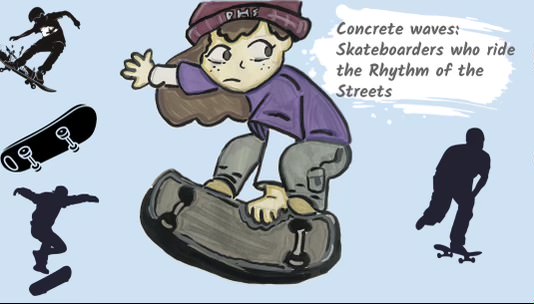Skateboarding is more than just a method of transportation; it is a culture, lifestyle and for many, a form of self-expression. What originally began as “sidewalk surfing” during the 1950s in California that later blew up during the 1990s, according to the National Museum of Play, skateboarding has now grown into a global interest that welcomes both creativity and athleticism.
One of the most enchanting aspects of skateboarding is its individuality, according to Grinnell College. There is no set path, nor is there a right or wrong way to skateboard. Each person caters to their own style, flow and approach.
“Style gets developed by yourself,” junior Parker Cherry said. “Every skater has their own style. Like Andy Anderson and Nyjah Huston, everybody skates a little bit differently. Anyone can learn through technical tricks, but how it looks and the way you put your own spin on it, I think makes the real difference.”
Skateboarding combines balance and timing to control a board. Tricks such as the kickflip (flipping the board mid-air), the ollie (popping the tail and sliding the front foot to lift off) and grind (sliding along a rail using the trucks) rely on precise footwork and momentum.
Recently, skateboarding has gained wider recognition from city authorities and charity workers, according to SkateHut. The sport debuted at the Tokyo 2020 Summer Olympics, demonstrating a roaring success within the Olympics and bringing global notoriety to a sport long considered underground. Although this recognition has not changed the raw spirit of skateboarding, it has opened more doors to the skateboarding community for beginning skaters worldwide.
“[I’ve been skateboarding for] over a year at this point,” sophomore Nathan Penuelas said. “A lot of friends were into it in middle school. I thought it was cool because I had seen old TV clips. It was scary at first because I don’t think my balance has ever been that good, but I got used to it. People are mostly positive. If you’re struggling with something, they’ll give you tips.”
Skating is often followed by a friendly and welcoming community, according to Burlington County Times. From beginner to pro, skaters help each other learn, progress and stay motivated.
“I love how the internet makes skateboarding a lot more accessible as there are now a plethora of tutorials that make it even easier to learn the sport,” sophomore Khonsu Marshall said. “I focus heavily on the technicalities of a trick. I watch a lot of tutorial videos and break every step down.”
The skateboarding community is often associated with a troubled attitude, according to Boise State University. Unlike many sports that follow a rulebook, skateboarding thrives on independence in the streets. However, this attitude does not mean exclusion, especially when the heart of skate culture is acceptance.
“I think [the community] gets a lot of hate because [many] people associate them with bad behavior,” Cherry said. “That’s not the case, especially with the scene around Irvine. For me and my friends, we’re not into any of that, but we also skate. Most skaters are like that since it’s a super physically demanding activity, it requires perseverance. We don’t really get angry because whenever we’re skating, we know that takes so much effort. So we learn how to deal with bad situations and overcoming things.”




